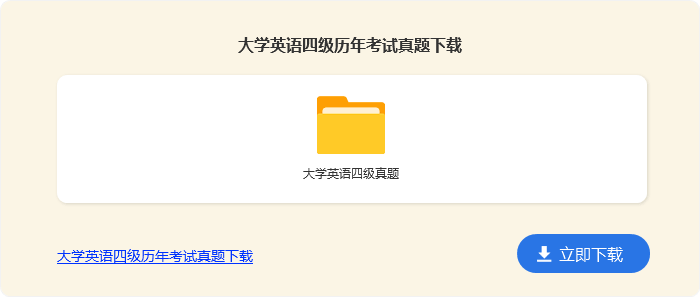
- 相关推荐
6月大学英语四级翻译练习题
翻译是英语六级考试中的最后一道题,考察方式是汉译英。下面是CN人才网为大家整理的2017年6月大学英语四级翻译练习题,欢迎参考~

2017年6月大学英语四级翻译练习题
印章篆刻
请将下面这段话翻译成英文:
中国的印章篆刻(seal carving)始于古代,贯穿于整个秦朝。篆刻的印帝最初是作为皇帝的玉玺(imperial seal)来使用的。皇家的印章被称为玺(Xi)并且只能由皇室成员使用。秦朝之后,更多不同种类的印章出现了。它们作为个性化的印戳用于私人用途。这些非官方定制的印戳被称为印(Yin)。在唐朝,由于迷信(superstition),印章的名称被改称为宝,理由是玺的发音与另一个表示“死亡”意思的汉字类似。
参考翻译:
Chinese seal carving first appeared in ancient times and was used throughout the Qin Dynasty. It was initially employed as an imperial seal named Xi. These imperial seal carvings were used only by the royalty. Following this dynasty, more different kinds of seals appeared and were used by private folks as personalized stamps. These non-official stamps were called Yin. During the Tang Dynasty, the seals was renamed Bao as a result of superstition since the pronunciation of Xi is similar to that of another Chinese charactcr which means death.
1.篆刻的印幸最初是作为皇帝的玉玺(imperial seal)来使用的:该句可译为被动句,谓语是"最初是作为…使用”,其中“使用”可用employ来表示,属于正式用语,故可翻译为was initially employed as。
2.由于迷信,印章的名称被改称为宝:“由于”可译为becauseof或as a rcsult of, 这两个短语后面都接名句或动名词。
黄梅戏
请将下面这段话翻译成英文:
黄梅戏(Huangmei Opera)源于湖北省黄梅县的采茶歌曲,连同京剧、越剧 (Yue Opera)、评剧(Ping Opera)和豫剧(Yu Opera)是中国的五大戏曲。它最初是以一种简单的载歌载舞的戏剧形式出现的。后来,随着饱受洪水灾害的灾民,黄梅戏传到了安徽省安庆市。它吸收了徽剧和当地歌舞的元素,发展到了今天的.形式。黄梅戏以一种淸新的风格反映了普通居民的生活,受到了群众的喜爱。
参考翻译:
Huangmei Opera was originated from tea pickingsongs in Huangmei county, Hubei province.It is oneof the Five Operas in China together with BeijingOpera, Yue Opera, Ping Opera and Yu Opera.It firstappeared as a simple drama of song and dance.Later, it was spread to Anqing city, Anhui province by immigrating victims of floods. Absorbingelements of Anhui Opera and local songs and dances, Huangmei Opera was developed to thepresent form. It enjoys great popularity among the masses by reflecting the life of ordinarypeople in a fresh style.
1.黄梅戏源于湖北省黄梅共的采茶歌曲,连同京剧、越剧、评剧和豫剧是中国的五大戏曲:后半句可以理解为“黄梅戏是中国五大戏曲之一”,即 Huangmei Opera is one of theFive Operas in China。再翻译句子的剩余部分连同京剧、越剧、评剧和豫剧”时,可将其着作是句子的状语,译为together with Beijing Opera, Yue Opera, PingOpera and Yu Opera。
2.它最初是以一种简单的载歌载舞的戏剧形式出现的:“简单的载歌载舞的戏剧形式”可译为a simple dramaof song and dance。
3.后来,随着饱受洪水灾害的灾民,黄梅戏传到了安徽省安庆市:该句可译为被动句,其中主干则是it wasspread to...by immigrating victims of floods。
儒家思想
请将下面这段话翻译成英文:
儒家思想
儒家思想(Confucianism)是中国影响最大的思想流派,也是中国古代的主流意识。自汉代以来,儒家思想就是封建统治阶级(feudal ruling class)的指导思想之一。儒家思想的核心其实是一种人道主义(humanism )。它提倡自我修养,认为人是可教化的、可完善的。儒家思想的一个宏大的目标就是实现“大同社会”,在这样的一个社会中,每个人都能扮演好自己的角色,并与他人维持良好的关系。
参考翻译:
Confucianism
Confucianism is the largest Chinese school ofthoughts, and the mainstream consciousness ofthe ancient China. Confucianism had been one of theruling doctrines of the feudal ruling class since theHan Dynasty. The core of Confucianism is actually a kind of humanism. It advocates self-cultivation, and believes that human beings are teachable and improvable. A grand goal ofConfucianism is to achieve a harmonious society in which each individual plays his or her partwell, and maintains a good relationship with others.
1.思想流派:可译为school of thoughts。
2.指导思想:可译为ruling doctrine,也可直译为guiding ideology。
3.自我修养:应翻译为self-cultivation。cultivate除了有“耕种;照料”之意,还可以表示“修养,改善”。
4.可教化的、可完善的:都可以使用动词加上“-able”这一形容词后缀的构词法,故分别为teachable和improvable。
5.大同社会:孔子所提出的“大同”的特征是:“大道之行也,天下为公。选贤与能,讲信修睦…”从字面上也可看出,“大同”即为“和谐”之意, 故“大同社会”可译为 harmonious society 或 perfect society。
6.每个人:除可译为everybody、everyone以外,还可译为each individual, 更加强调个体。“扮演好某人的角色”即为play one's part/role well。
【6月大学英语四级翻译练习题】相关文章:
大学英语四级翻译练习题10-18
英语四级短文翻译技巧09-30
英语四级阅读理解练习题01-20
历年大学英语四级写作类型盘点06-17
四级英语作文模板12-31
英语四级范文12-31
6月大学英语四级阅读理解题04-02
英语四级作文大学生住宿(通用23篇)11-24
大学英语四级成绩单该如何辨真伪11-11
新四级英语作文模板12-31






